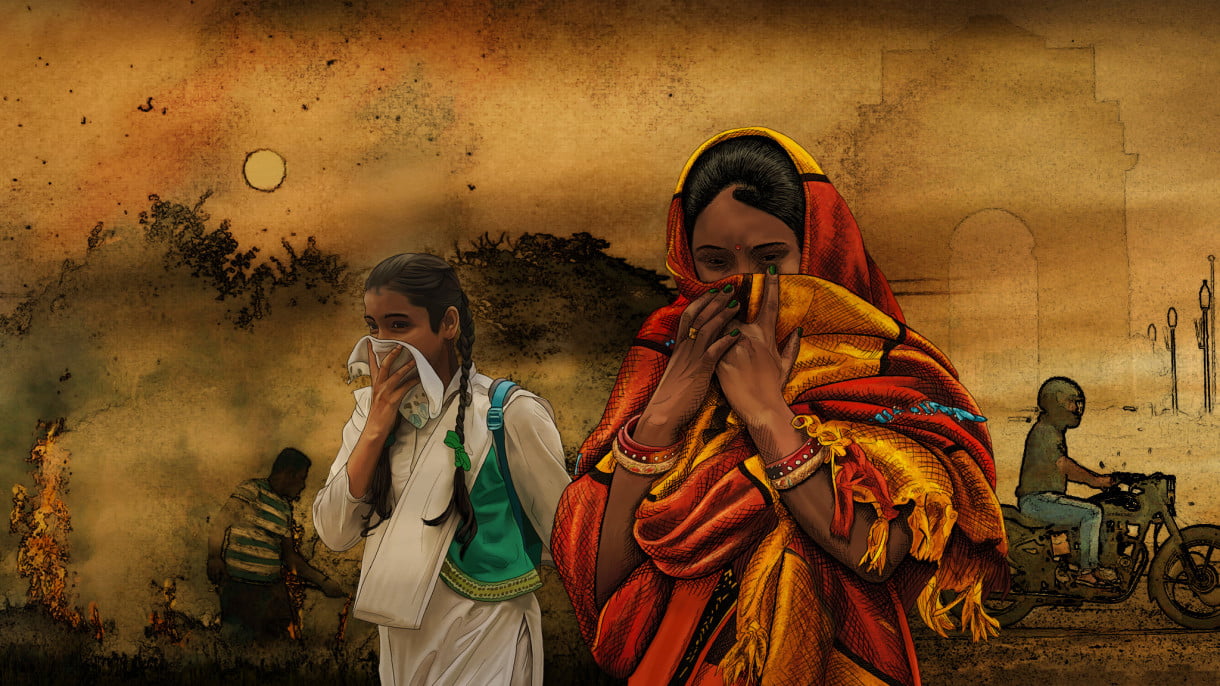According to a 2018 Greenpeace and AirVisual analysis of air pollution readings from 3,000 cities around the world, 22 of the world’s 30 most polluted cities in terms of air are in India. Millions lose their lives every year in India because of health complications that are a direct consequence of the high levels of air pollution. Such data made me wonder, how are Indian women faring in such dire circumstances?
Not very well, for starters.
A recent study published in the journal Nature Sustainability shows how high level of air pollution can cause ‘silent’ miscarriages. While signs of a typical miscarriage might be obvious, such as vaginal bleeding and cramping, a ‘silent’ miscarriage happens when the foetus has died, but the body hasn’t expelled it and though there’s no fixed cause of such a miscarriage, the study reveals how highly polluted air puts women at greater risk of having one. This study, which is a result of a collaborative effort from 16 different authors across several universities in China, also found that expectant mothers who were older than 39, as well as farmers and working class women were at a higher risk of ‘silent’ miscarriages associated with air pollution.
Millions of women living in rural areas have to deal with the health complications like strokes, pulmonary disease, lung cancer and heart disease of prolonged exposure to household air pollution.
This Chinese study isn’t an exception. Numerous studies done in the past have also shown that air pollution increases the risk of premature birth and complications during pregnancy like preeclampsia, and gestational hypertension. While one might think it is only women living in these Indian cities who are silently suffocating, women in rural areas have it far worse. They are exposed to indoor air pollution almost every day, which is far more dangerous, because compact enclosed spaces allow potential pollutants to build up more than open spaces. Indoor air pollution is primarily caused by the inefficient burning of solid fuels like firewood, coal and dung cakes, all of which are indeed used by most rural households for cooking food. Millions of women living in rural areas have to deal with health complications like strokes, pulmonary disease, lung cancer and heart disease of prolonged exposure to household air pollution.
So what is India doing about it? What is being done to provide clean fuels such as electricity, natural gas, advanced biomass cooking stoves or liquefied petroleum gas (LPG) in rural households?
Well, not much apparently. Launched in May 2016, the Pradhan Mantri Ujjwala Yojana (PMUY) aimed to promote clean cooking fuels providing poor women with free LPG connections. And though there’s been a spike in the number of LPG connections, they aren’t being used much, according to a survey done in rural north India. Based on the data from 1,216 households in villages across Bihar, Madhya Pradesh, Rajasthan and Uttar Pradesh between 2014-2018, the survey showed that as much as 98% households had an LPG connection, but also used the traditional Indian earthen chulha. A mere 27% of these households exclusively used LPG.
Also read: How To Travel Without Expanding Your Ecological Footprint
And why that might be?
People who are covered under the Ujjwala scheme cannot afford buying LPG cylinders at the same price as most of the urban India does, and refilling these cylinders comes with its own extra cost.

According to a report by Livemint on the survey, the authors also studied the behavioural challenges that have led to such circumstances. Quite a lot of respondents feel that food that is cooked on a chulha might be healthier than that cooked with the help of LPG, despite of it having a harmful impact on the health of the women. And the number of deaths certainly haven’t gone down. According to a study titled, State of Global Air 2019, 1.2 million died in India in 2017 due to exposure to outdoor and indoor pollution.
Another thing that the research underlined was the fact that though these LPG connections are registered under the name of the adult women in the house, only one-third of the women in the surveyed household decided when to order an LPG cylinder- and only in 14% of the households did women place the order for the cylinder.
There’s nothing wrong with schemes like PMUY, but even subsidised connections come with their own set of problems. A research done by the Council on Energy, Environment and Water, which is an independent, not-for-profit policy research institution, showed how factors like the distance traveled to obtain the LPG cylinder is also a factor into the choice of using LPG cylinders in households. Another thing that the research underlined was the fact that though these LPG connections are registered under the name of the adult women in the house, only one-third of the women in the surveyed household decided when to order an LPG cylinder and only in 14% of the households did women place the order for the cylinder.
Since men mostly remain the decision-making authority on household expenses, the researchers suggest that, “It would be prudent to sensitise elder members and spouses of PMUY beneficiaries—often the primary decision-makers or the influencers in the households—through platforms such as LPG Panchayat.”
Air Pollution is clearly a gendered issue. Women are impacted much more by household air pollution than men. Approaches taken to solve the problem will not be able to work unless they tackle the issue of gender inequality. Providing rural women access to clean cooking fuel shouldn’t just be left to schemes like PMUY, but should also involve a multi-sector approach to address the impact of using solid fuel on women’s health too.
Also read: Capitalism And Colonisation: How The Climate Change Movement Is Being Whitewashed
Featured Image Source: Financial Times
About the author(s)
Purnima is a wannabe writer and a want-to-be cat mom.




